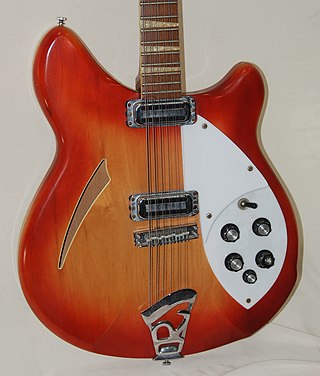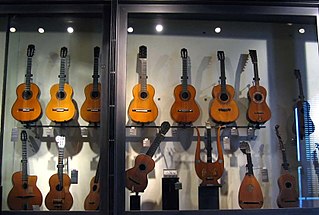
An electric guitar is a guitar that requires external amplification in order to be heard at typical performance volumes, unlike a standard acoustic guitar. It uses one or more pickups to convert the vibration of its strings into electrical signals, which ultimately are reproduced as sound by loudspeakers. The sound is sometimes shaped or electronically altered to achieve different timbres or tonal qualities from that of an acoustic guitar via amplifier settings or knobs on the guitar. Often, this is done through the use of effects such as reverb, distortion and "overdrive"; the latter is considered to be a key element of electric blues guitar music and jazz, rock and heavy- metal guitar playing. Designs also exist combining attributes of the electric and acoustic guitars: the semi-acoustic and acoustic-electric guitars.

The guitar is a fretted musical instrument that typically has six strings. It is usually held flat against the player's body and played by strumming or plucking the strings with the dominant hand, while simultaneously pressing selected strings against frets with the fingers of the opposite hand. A plectrum or individual finger picks may also be used to strike the strings. The sound of the guitar is projected either acoustically, by means of a resonant chamber on the instrument, or amplified by an electronic pickup and an amplifier.
Rickenbacker International Corporation is a string instrument manufacturer based in Santa Ana, California. The company is credited as the first known maker of electric guitars – a steel guitar in 1932 – and today produces a range of electric guitars and basses.

James Roger McGuinn is an American musician. He is best known for being the frontman and leader of the Byrds. He was inducted into the Rock and Roll Hall of Fame for his work with the Byrds. As a solo artist he has released 10 albums and collaborated with, among others, Bob Dylan, Tom Petty and Chris Hillman. The 12-string Rickenbacker guitar is his signature instrument.

A twelve-string guitar is a steel-string guitar with 12 strings in six courses, which produces a thicker, more ringing tone than a standard six-string guitar. Typically, the strings of the lower four courses are tuned in octaves, with those of the upper two courses tuned in unison. The gap between the strings within each dual-string course is narrow, and the strings of each course are fretted and plucked as a single unit. The neck is wider, to accommodate the extra strings, and is similar to the width of a classical guitar neck. The sound, particularly on acoustic instruments, is fuller and more harmonically resonant than six-string instruments. The 12-string guitar can be played like a 6-string guitar as players still use the same notes, chords and guitar techniques like a standard 6-string guitar, but advanced techniques might be tough as players need to play or pluck two strings simultaneously.

Jangle or jingle-jangle is a sound typically characterized by undistorted, treble-heavy electric guitars played in a droning chordal style. The sound is mainly associated with pop music as well as 1960s guitar bands, folk rock, and 1980s indie music. It is sometimes classed as its own subgenre, jangle pop. Music critics use the term to suggest guitar pop that evokes a bright mood.

B.C. Rich is an American brand of acoustic and electric guitars and bass guitars founded by Bernardo Chavez Rico in 1969.
Variax is the name of a line of guitars developed and marketed by Line 6. They differ from typical electric and acoustic guitars in that internal electronics process the sound from individual strings to model (replicate) the sound of specific guitars and other instruments. The maker claims it is the first guitar family that can emulate the tones of other notable electric and acoustic guitars. It also provides a banjo and a sitar tone. The Variax is currently available as an electric guitar, but modeling acoustic guitars and modeling electric bass guitars have been available in the past.

A tailpiece is a component on many stringed musical instruments that anchors one end of the strings, usually opposite the end with the tuning mechanism.

"If I Needed Someone" is a song by the English rock band the Beatles, written by George Harrison, the group's lead guitarist. It was released in December 1965 on their album Rubber Soul, except in North America, where it appeared on the June 1966 release Yesterday and Today. The song reflects the reciprocal influences shared between the Beatles and American band the Byrds. On release, it was widely considered to be Harrison's best song to date. A recording by the Hollies was issued in Britain on the same day as Rubber Soul and peaked at number 20 on the national singles chart.

The following outline is provided as an overview of and topical guide to guitars:

A headstock or peghead is part of a guitar or similar stringed instruments such as a lute, mandolin, banjo, ukulele and others of the lute lineage. The main function of a headstock is to house the tuning pegs or other mechanism that holds the strings at the "head" of the instrument; it corresponds to a pegbox in the violin family. At the "tail" of the instrument the strings are usually held by a tailpiece or bridge. Machine heads on the headstock are commonly used to tune the instrument by adjusting the tension of strings and, consequently, the pitch of sound they produce.
The Fender Electric XII is a purpose-built 12-string electric guitar, designed for folk rockers. Instead of using a Stratocaster-body style, it uses one similar to a Jaguar/Jazzmaster body style. It also departed from the typical "Stratocaster"-style headstock, instead featuring a long headstock nicknamed the "hockey-stick" headstock to cope with the twelve tuners. The original Electric XII employed a unique split pickup design and had a 4-way pickup rotary selector allowing for neck, neck & bridge in parallel, in or out of phase, and bridge only options as opposed to the Alternate Reality version which sports a standard 3-way toggle switch for pickup selection. It also used a string-through-body design similar to a Telecaster to help increase sustain.

The Epiphone Casino is a thinline hollow body electric guitar manufactured by Epiphone, a branch of Gibson. The guitar debuted in 1961 and has been associated with such guitarists as Howlin' Wolf, George Harrison, John Lennon, Paul McCartney, Noel Gallagher, Keith Richards, Dave Davies, Brad Whitford, Shirley Manson, Paul Weller, The Edge, Josh Homme, Daniel Kessler, Brendon Urie, Gary Clark, Jr., Glenn Frey, John Illsley, and Peter Green.

The Rickenbacker 330 is part of Rickenbacker's 300 series of guitars. The 330 entered the Rickenbacker product line in 1958, though at the time the 300 series of guitars was known as the "Capri" series. It was designed by the German luthier Roger Rossmeisl. The guitar is associated by many players with the jangle-rock sounds of bands from the 1960s and 1980s. The instrument incorporates many features standard on Rickenbacker guitars, including a three-ply maple/walnut neck, a shallow headstock angle, and a thick rosewood fretboard finished with clear conversion varnish. The 330 also features a body with Rickenbacker's "crescent moon" double-cutaway shape with sharp, unbound edges, and an "R"-shaped trapeze tailpiece. One idiosyncrasy of the guitar is its dual truss rods, which allow for the correction of problematic and unwanted twists, as well as curvature, of the guitar's neck. The 330 is equipped with a monaural jack plate, lacking the Rick-O-Sound stereo functionality of other Rickenbacker models such as the Rickenbacker 360.

The Rickenbacker 360 is an electric, semi-acoustic guitar made by Rickenbacker, and part of the Rickenbacker 300 Series. The instrument incorporates many features standard on Rickenbacker guitars, including a three-ply maple/walnut neck, shallow headstock angle, a thick rosewood fretboard finished with clear conversion varnish, and double truss rods. The 360 also features stereo or mono output, a body with Rickenbacker's "crescent moon" cutaway shape and rounded top edge and bound back, and an "R"-shaped trapeze tailpiece. A twelve-string version of the 360 is available. A three-pickup version of this model is also available, the 370.
The Rickenbacker 300 series is a series of semi-acoustic guitars manufactured by the Rickenbacker Company. The series was launched in 1958, shortly after F.C Hall took over Rickenbacker. The guitars were created by Roger Rossmeisl, a German guitar maker.

Sigma Guitars is a guitar manufacturing brand originally released by C.F. Martin as a line of guitars at affordable prices to compete with the increasing number of imported guitars from Japan and elsewhere. The Sigma line was discontinued by Martin in 2007. The rights to the name were acquired by German company AMI Musical Instruments GmbH, which relaunched the brand with guitars being produced in China.

The Rickenbacker 400-Series was a line of lower cost solid body electric guitars that Rickenbacker introduced in 1956.















